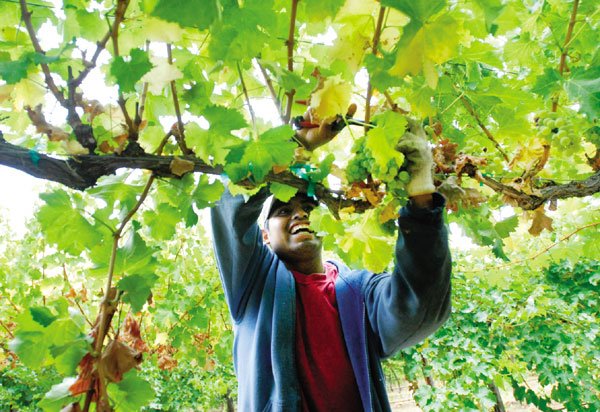Winemakers and vineyard owners in South County are moving to
contain the proliferation of the European Grapevine Moth after it’s
discovery in two South County vineyards forced a 93-square-mile
quarantine of grapes.
Winemakers and vineyard owners in South County are moving to contain the proliferation of the European Grapevine Moth after it’s discovery in two South County vineyards forced a 93-square-mile quarantine of grapes.
The three moths that sparked the measures were discovered Sept. 15 and 17 in Jason-Stephens Wineries and Kirigin Cellars in Gilroy.
Jason-Stephens Winery Manager Jason Goelz is not alarmed yet, but said he prefers to err on the side of caution. Two of the moths were trapped at his winery.
“It’s a little bit scary, but finding two is not that scary yet,” said Goelz, adding he is confident the quarantine measures and the pesticide program will eradicate the moth. “But it would be horrible if it spread.”
To make sure this doesn’t happen, Santa Clara County officials have been alerting winemakers and growers on new regulations they will have to adhere to during the quarantine.
All bulk grapes, harvest bins and equipment must follow rules for leaving the quarantined area after Kevin O’Day, acting Santa Clara County agricultural commissioner, announced the quarantine and eradication plan Thursday.
O’Day and his team of field biologists have been in contact with area winemakers, growers and homeowners explaining the eradication process.
Currently, winemakers and growers can use their current crop of grapes for commercial purposes, while homeowners are being asked by the county to dispose their fruit, O’Day said.
“We’ve been starting at the epicenter and working our way out,” he said. “It’s important that they understand what the individual steps are for containing the pest. The grower, the trucker and the winery sign different agreements and have different expectations and requirements.”
The European Grapevine Moth, first discovered in California during a Sept. 2009 quarantine in Napa, is dormant in winter. They house themselves in wine grape clusters, feed on ripening grapes and expose them to further damage through fungal infections in the spring, according to O’Day. The moths can cause the grapes to brown and rot and can ruin an entire crop if they reproduce and spread.
The county’s strategy for the removal of the moth is a two-step process of containment and eradication.
The first step is containment with the regulations of covering grapes when transported outside a winery or vineyard, crushing the product within two hours of arrival and the proper disposal of waste including the green stem that could still house the moth.
The boundaries of the quarantine in Santa Clara County are Llagas Road in Morgan Hill on the north, Foothill Avenue and New Avenue in Morgan Hill, San Martin and Gilroy on the east, Miller Avenue in Gilroy on the south and the Santa Clara-Santa Cruz County line on the west.
At least two quarantine meetings will be held with grape growers before eradication begins in spring, but O’Day is giving growers some time to tend to their harvest before establishing a a schedule.
“To do nothing and just live with it may not be an option for growers,” said O’Day. “There will be loss of markets if we can’t ship grapes out.”
Thirty-nine grape growers accounting for 620 acres of grapes will be affected by the quarantine. The grape growing season is coming to an end, with the harvest usually timed for October.
Delimitation traps have been set up in the quarantine area to determine the scope of the infestation. The traps are used only to detect how many moths may be in an area, and not to eliminate them.
Pesticides or mating disruption strategies using pheromones could be the next step in eradicating the pests, O’Day said.
Since winemakers and growers are still allowed to collect their harvest and produce wine, they are not concerned about the moth damaging this year’s yield.
“It shouldn’t affect our production, and if it does, it would be a long-term effect,” Goelz said.
The biggest concern for growers is they don’t want to see the moths multiply and become established, said O’Day. Because this foreign insect has been introduced into the ecosystem, it doesn’t have any natural enemies, he said.
Even after announcing the quarantine, O’Day is reluctant to press the panic button.
“This is an extremely small number of pests. We are fortunate its confined to a small area,” he said adding no more moths have been found since mid-September.
Kirigin Cellars owner Dhruv Khanna said his guess at how the pest was introduced into his property is as good as anyone else’s.
“We use all of our grapes to make wine on the premise, and we don’t sell grapes, so we are very comfortable that we are not a propagator,” he said.
In South County, grapes are the eighth top-selling crop. Wine production in Santa Clara County in 2009 was worth $6.98 million, according to the Santa Clara Division of Agriculture. More than 5,600 tons were produced that year with about three to five tons produced for every acre.
“There are some concerns because we know how destructive the insect can be, but I believe we are taking some precautions to not transport the insects around the area,” said Vic Vanni, the owner of Solis Winery and president of Wineries of Santa Clara Valley.
The Solis Winery operates 16 acres and is about three miles from where the moths were found. Vanni said the quarantine won’t affect his winery as severely as it could others since they don’t export any products outside South County.
“It’s good timing we found it now, rather than later during the harvest,” Vanni said.
California tops the list in the nation of grape growers. In 2009, the grape harvest was worth $2.74 billion – about a third of which was produced in the Napa Valley.
Last year, the European grapevine moth was discovered in Napa, Sonoma and Solano counties, causing a 162-square-mile quarantine and major concerns by the state’s most lucrative area for grape growing and winemaking. Statewide trapping ensued and quarantine restrictions are now in place in each of those counties.
The moth hails from Europe, South America, North Africa, Israel and now California.
“It’s really scary,” said Jan Garrod, the Santa Clara County Farm Bureau’s president and owner of Cooper-Garrod Vineyard in Saratoga.
“The unfortunate thing is that this is the end of the season. Now, they’re going to go into the ground, under the debris and we won’t see them again. I know the ag commissioner is going full barrel to see how extensive the problem is. Any time we have an invasive species like this, we got to get it right away.”
South County has slightly more than 1,500 acres of grapes – the largest cluster of grape growers in the county, Garrod said.
“It’s nothing to sneeze at. But I think (O’Day) is being optimistic. They’re putting the traps out there before these moths go into the dormant state. (In the spring), they’re going to be bigger. We don’t know what’s going to happen,” he said.













